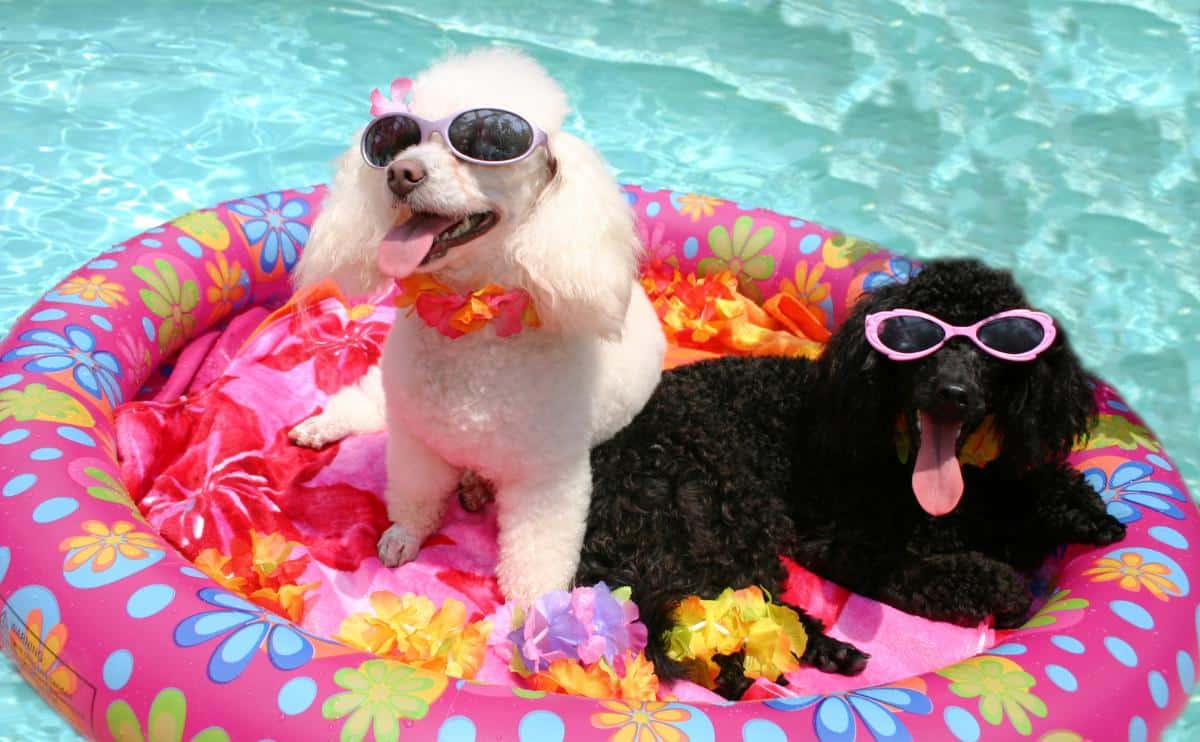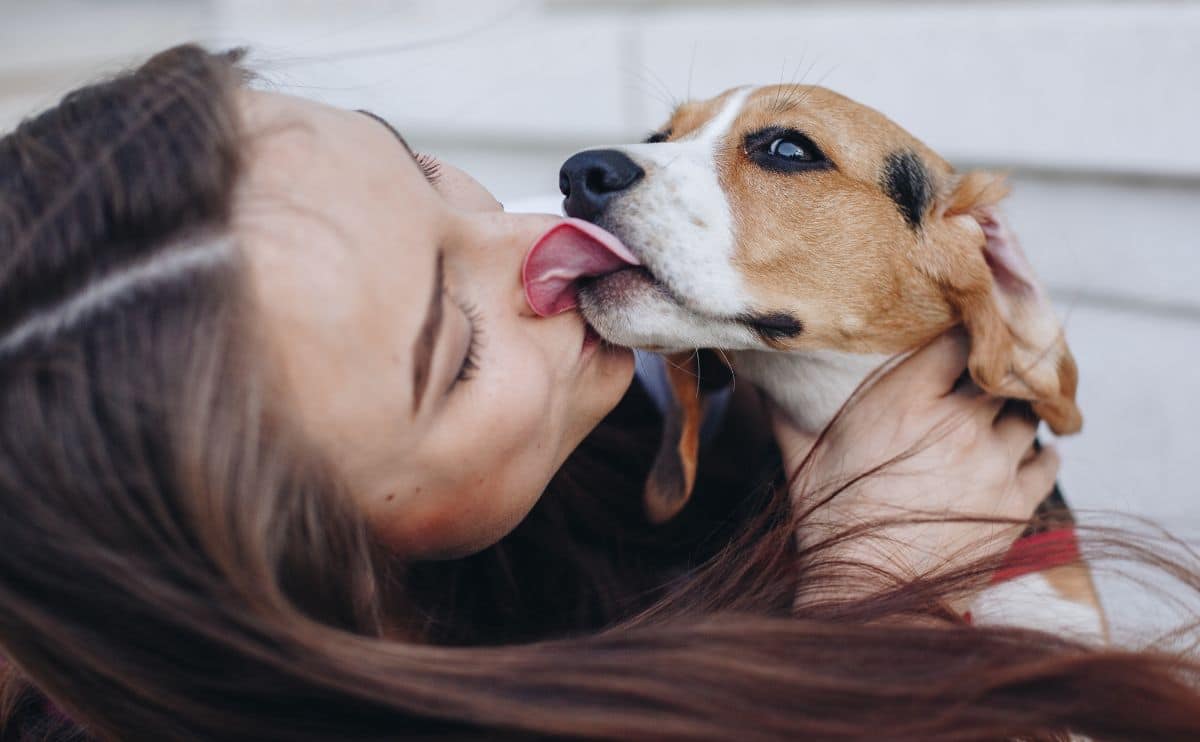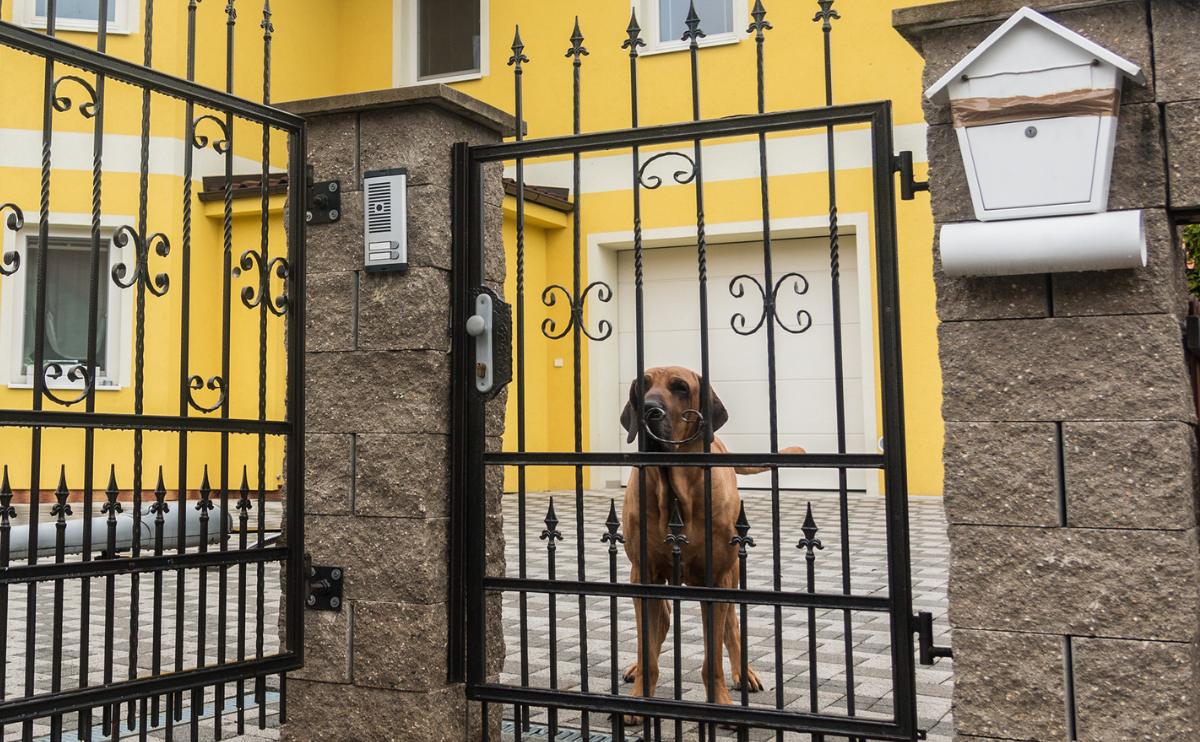Your Dog Just Got Skunked—Here’s How To Fix It
When you purchase through links on our site, we may earn a commission. Here’s how it works.
Your dog just got sprayed by a skunk; welcome to Eau de Disaster. That smell could last three weeks unless you act right now.
Table of Contents
Lucky for you (and your nostrils), this guide to skunk rehab gets straight to the relief with no tomato juice nonsense involved.
The First Hour: Why Every Minute Counts
Skunk oil bonds with your dog’s coat fast. The longer you wait, the more it sets in. For the love of your nostrils and upholstery, start cleaning within 30 minutes.
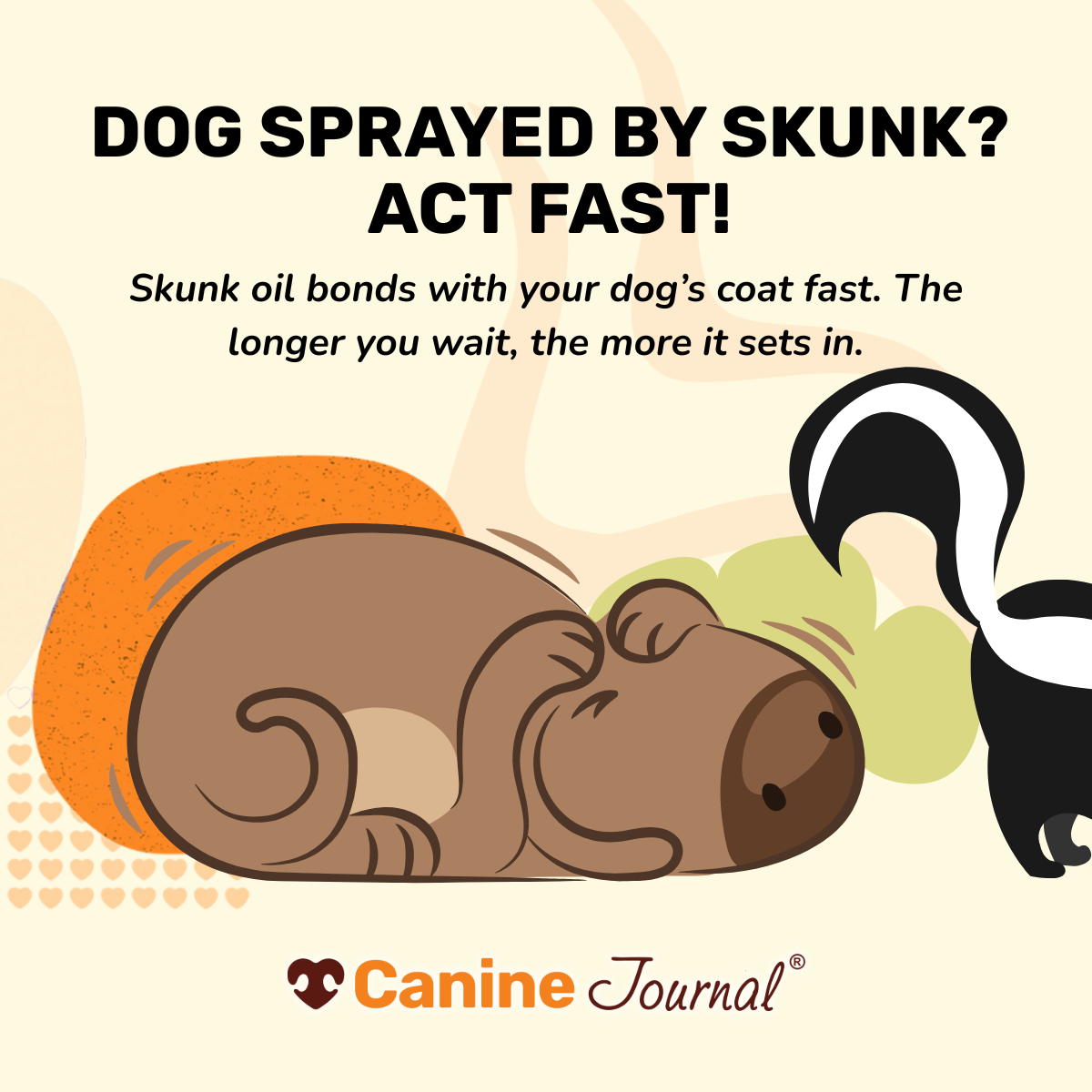
Quick Tips
- Prepare your cleaning mix before touching the dog
- Keep your dog outside
- Put on gloves
Skunks Aren’t Just Smelly, They’re Tactical
Skunks are like villains in a cartoon, except their weapon is not a comically oversized mallet. When they spray, it’s not random. They aim with shocking precision, usually targeting the face.
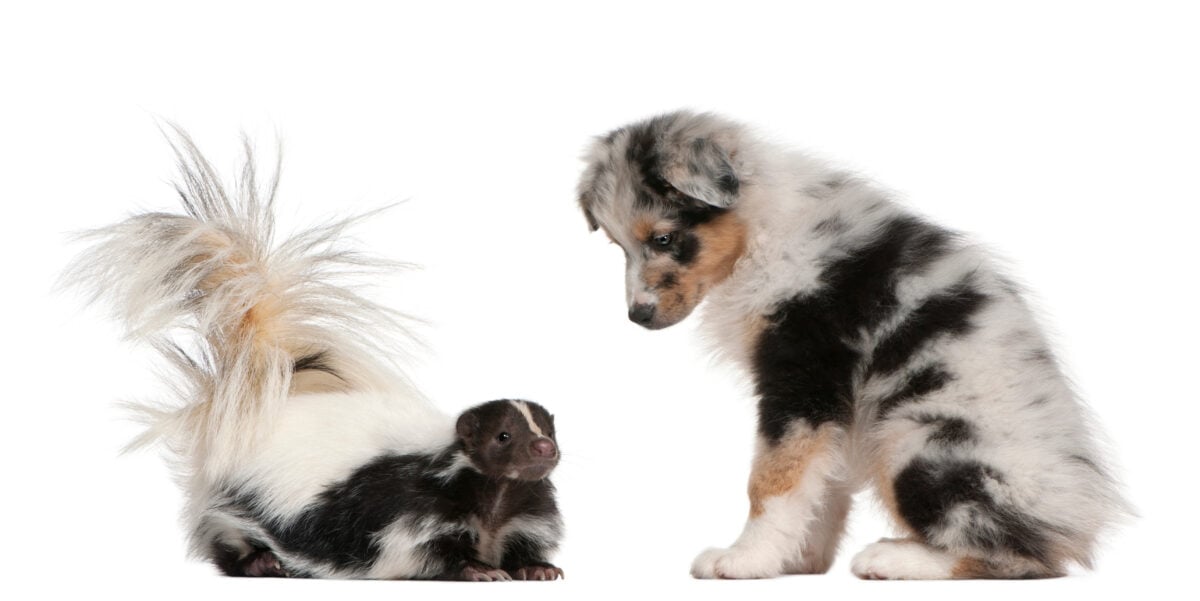
Why? Because they’re trying to disable the threat fast. The spray causes temporary blindness and intense irritation, which gives the skunk time to waddle off in smug victory.
If your dog is pawing at its eyes or squinting, it may have taken a direct hit. The thiols in the spray can burn, sting, and even cause inflammation in mucous membranes. Some dogs panic, bolting through yards, crashing into fences, or trying to rub their face into the nearest rug, wall, or, if you’re unlucky, your leg.
Even worse, the oil in skunk spray is hydrophobic—it doesn’t dissolve in water alone. That means even if your first instinct is to hose your dog down, you’re probably just spreading the stink deeper into the fur. Water can actually lock the smell in.
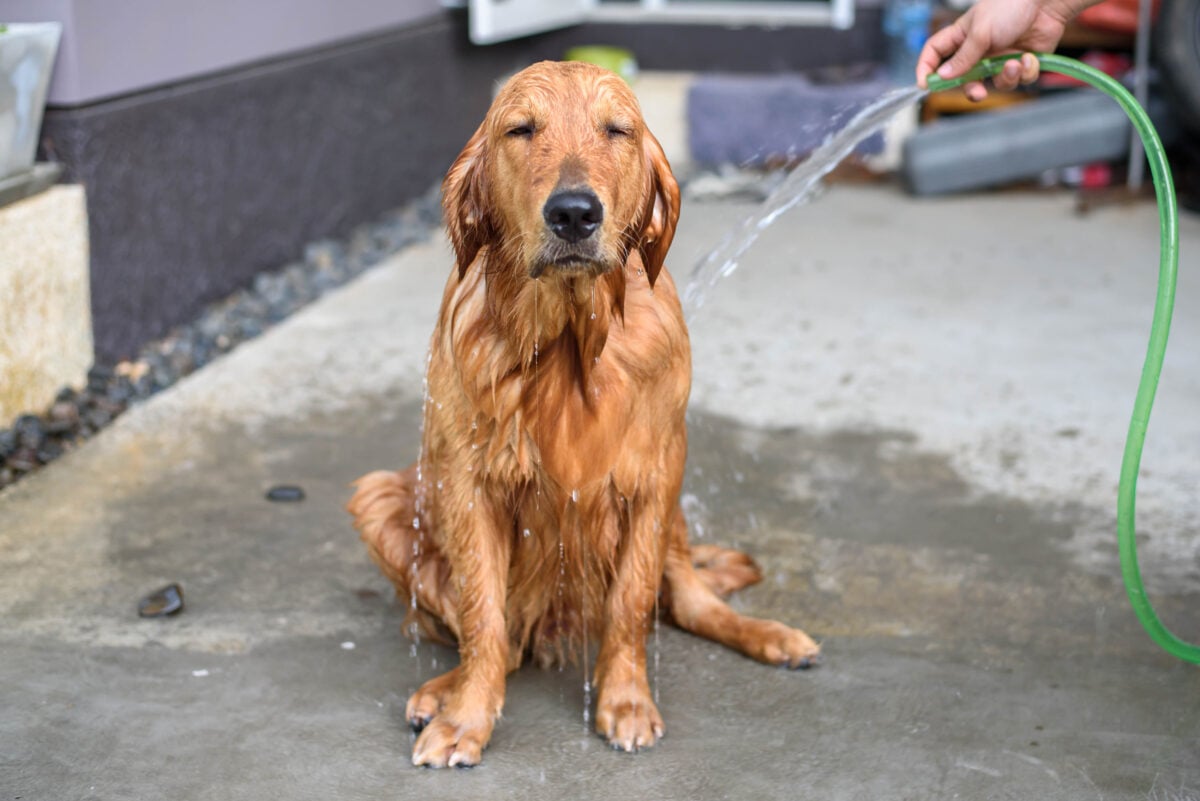
The correct response starts with restraint and preparation.
Keep your dog calm and leashed. Avoid letting them inside. Prep the de-skunk solution outside before attempting cleanup.
And remember, your dog didn’t choose this battle. They were just brave enough—or unlucky enough—to bark at the wrong tail.
If your dog is rubbing its eyes, drooling, or whining, you may need to visit the vet. Stay calm and keep your pet leashed.
Our Personal Experience With Dog Being Sprayed By A Skunk
Having had a German Shephard dog sprayed by a skunk twice in the same walk many years ago, I can tell you from experience that it’s very unpleasant. I highly recommend that you take steps to remediate the smell as soon as possible after the spraying.
– Neil G., dog owner
Daisy vs. The Skunk: A Tragedy In Three Acts
It was supposed to be a normal bedtime potty break. Peaceful. Uneventful. Maybe even a little boring.
But no. The universe had other plans.
Daisy trotted outside, tail high, nose twitching like a bloodhound on a mission. And then I heard it.
That bark. Not the ‘Hey neighbor’ bark. The other one. The ‘Something’s out here, and it’s horrifying’ bark.
I sprinted out barefoot, clutching a flashlight like it was a weapon. Too late.
There, in the glow of the porch light, stood the villain. Black. White. Fluffy-tailed. Smug.
And there was Daisy, rolling on the ground like she was trying to erase her face, pawing desperately at her eyes, looking utterly betrayed by the night.
The smell hit me like a freight train made of burning tires and garlic farts. It wasn’t just bad. It was apocalyptic.
We bathed her in baking soda. We shampooed. We apologized to the gods.
Unfortunately, she still smelled like a haunted onion. Eventually, after dry shampoo, scented sprays, and what felt like a full bottle of Febreze, she was. .. tolerable.
Lesson learned. No matter how brave your dog is, they are no match for a skunk with a grudge.
– Danielle Degroot, Daisy’s Owner & Canine Journal Writer

What Skunk Spray Actually Is (And Why It’s So Impossible to Wash Off)
Skunk spray isn’t just a bad smell, it’s biochemical warfare.
The scent comes from sulfur-based compounds called thiols. They’re oily, clingy, and engineered by nature to send predators running.
A skunk can spray up to 15 feet with sniper-like precision, and the results are immediate and traumatic.
Tomato juice? That’s a myth. It might temporarily mask the odor, but it doesn’t break down the thiols. All you’re doing is layering vegetable scent over sulfur.
The only way to neutralize skunk spray is with a chemical reaction, specifically oxidation. That’s where the hydrogen peroxide and baking soda mix comes in.
When combined, these ingredients create an oxidizing reaction that alters the thiols’ molecular structure. That’s why this DIY de-skunk solution works when nothing else will. It’s basic chemistry with heroic timing.
5 Weird Myths About Skunk Spray That Dog Owners Still Believe
Think you’ve heard every trick in the book for getting rid of skunk stink? Not so fast. There’s a skunky swamp of misinformation out there: home remedies, old wives’ tales, and advice that smells almost as bad as the problem.
Here are the biggest myths dog owners keep falling for:
1. Tomato Juice Works
It doesn’t. At best, it masks the odor for a few hours. At worst, it makes your dog smell like a salad bar exploded.
The thiols in skunk spray need to be oxidized to be neutralized—tomato juice can’t do that.
2. Skunks Only Spray Once
Nope. Skunks can hold multiple sprays in reserve and fire again if they feel threatened. Think of it as nature’s grossest water gun—fully loaded.
3. Rain Will Wash It Off
Not really. Skunk oil is hydrophobic, meaning it repels water. Rain might spread the stink deeper into your dog’s coat rather than rinsing it away.
4. Febreze Fixes Everything
Not when it comes to skunk. Febreze works by trapping odors, but it doesn’t break down the chemical compounds in skunk spray.
You’ll just end up with skunk-scented lavender.
5. Dogs Avoid Skunks After One Spray
We wish. Some dogs are thrill-seekers, others are just … not that bright.
Many will chase a skunk again like it’s the first time. See: Why Dogs Never Learn.
The Real DIY De-Skunk Recipe
The sooner you can clean the skunk oil off of your dog, the better the result since it won’t have saturated your dog’s coat as much.
Tomato juice doesn’t work. Neither do vinegar, bleach, or your favorite vanilla-scented body spray. Some can even make things worse by locking in the odor or irritating your dog’s skin.
What you need is a proven chemical reaction.
Ingredients
- ¼ cup of baking soda
- 1-2 teaspoons of mild dish detergent
- 1 quart of 3% hydrogen peroxide
Directions
- Mix all of the ingredients into a bucket.
- Work the foaming mixture well into your dog’s coat.
- Leave the mixture on your dog’s coat for 5 minutes.
- Rinse the mixture off with warm water.
- Follow with bathing your dog with his dog shampoo if desired, but not required.
Extra Tips
- Be careful applying this solution around your dog’s eyes as it may burn.
- Don’t use higher than 3% hydrogen peroxide as it may burn your dog’s skin.
- Only use the mix fresh. Storing the mixture in a closed container may cause it to explode.
- Hydrogen peroxide may bleach your dog’s coat if left on too long, so be sure to rinse it off after 5 minutes.
- If your dog was sprayed directly in the face, rinse their eyes with cool water.
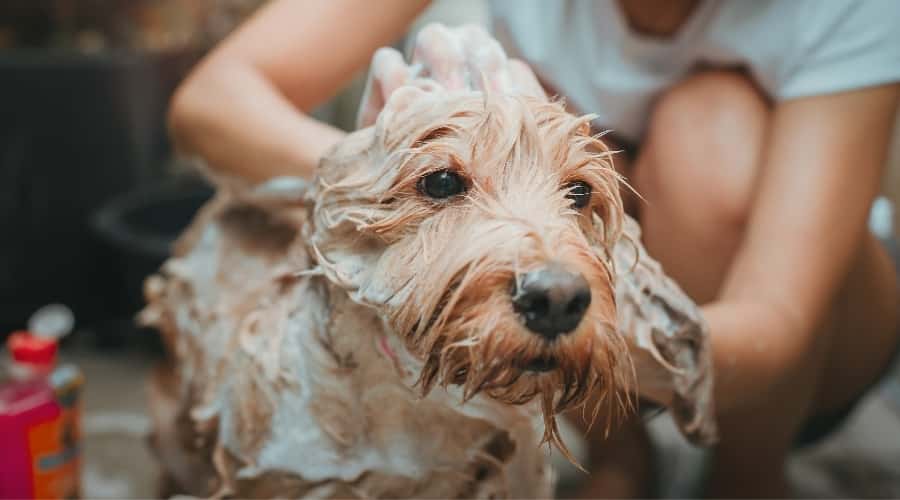
Shower yourself thoroughly after de-skunking your dog. The solution can also be used on people, so if you get any skunk oil on you, you can use the solution to eliminate the odor.
Protect Your Home: Couch, Car & Kids
That skunk stench spreads faster than gossip. Here’s how to limit the damage:
- Cover furniture before the dog comes in
- Toss anything washable in hot water with baking soda
- Ventilate rooms with fans and open windows
- Keep children away until cleanup is done
Red Flag Symptoms: When To Call The Vet
Call your vet immediately if you notice:
- Drooling or foaming
- Red, irritated eyes
- Vomiting or disorientation
- Breathing issues
Skunk spray can cause chemical burns or temporary blindness. Don’t wait to get medical help if symptoms appear.
Skunk-Proofing Your Yard
Pepe Le Pew might have made it look cute, but skunk spray is brutal.
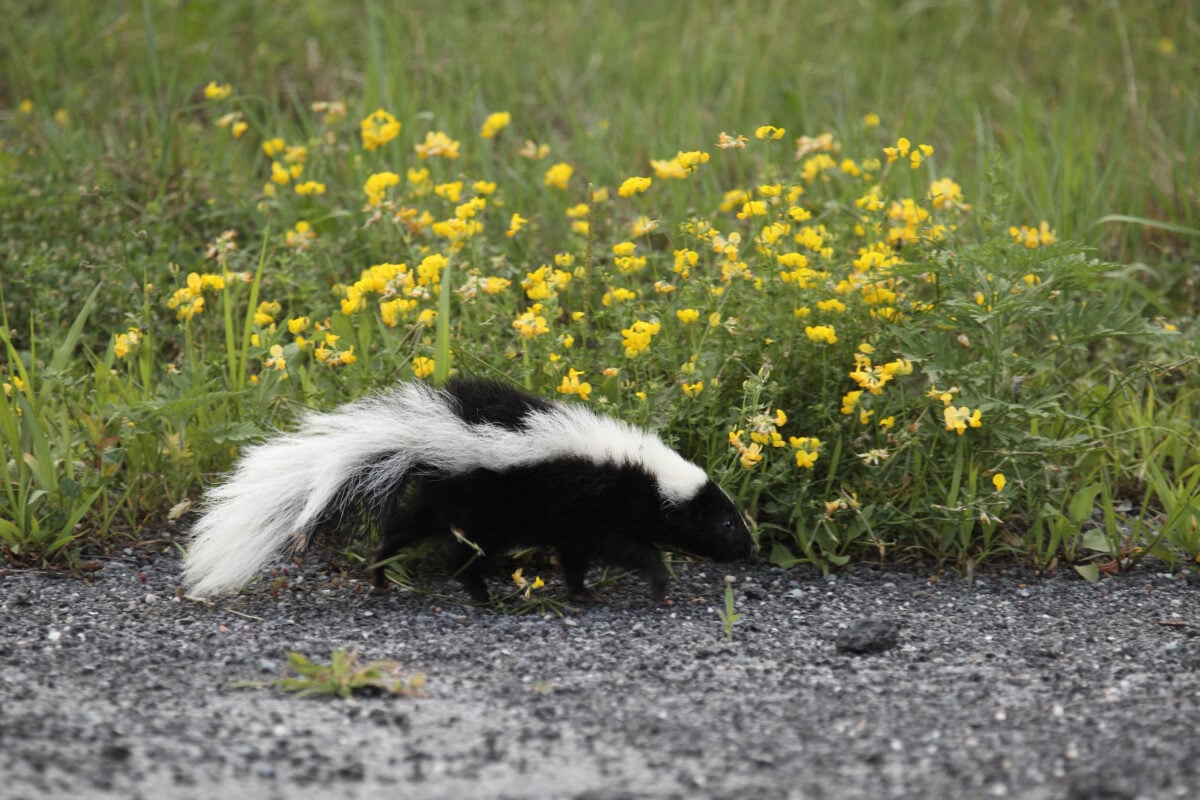
Prevent a repeat encounter with a few changes:
- Seal off gaps under porches and sheds
- Take food dishes inside after feeding
- Install motion-sensor lights
Skunks are nocturnal and love easy meals. Remove the invitation.
How To Clean Up Yourself After A Skunk Incident
Here’s what to do if you got hit while handling your dog (or just standing too close during the fallout).
Clothing
Soak in a bucket of warm water with one cup of baking soda and a splash of vinegar. Let sit for 30 minutes, then wash in hot water.
Add a second rinse cycle if needed. Don’t toss it in the dryer unless you want permanent stank.
Skin & Hair
Wash exposed skin with dish soap and rinse with a baking soda paste. Use a clarifying shampoo followed by a conditioner with citrus or charcoal for hair.
Avoid heavy perfumes—those mix in weird ways.
Shoes & Gear
Wipe down with hydrogen peroxide or enzyme cleaner. For fabric shoes, repeat the clothing routine above.
And next time? Gloves, old clothes, and maybe even goggles.
Cleaning The House After The Attack
If your dog got inside, you’re not just cleaning the pup. Here’s how to freshen your home:
- Mop hard surfaces with vinegar and water
- Boil vinegar on the stovetop to help eliminate the skunk odor in the air
- Sprinkle baking soda on carpets, wait 30 minutes, then vacuum
- Use enzyme cleaners on fabric
- Place charcoal odor absorbers around the house
Skunk Spray & Shampoo For Dogs
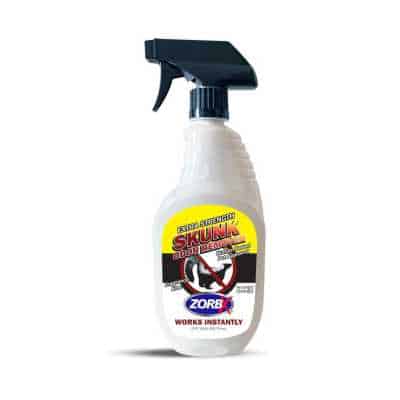
Does your dog have frequent skunk encounters? You may want to consider having this skunk odor remover from Zorbx on hand to get the smell out of your dog’s fur.
You can purchase it in the original or lavender scent. It’s guaranteed to work or your money back, and it can be used on pets, carpet, clothes and other contaminated surfaces.
Why Dogs Never Learn: The Skunk Science They Ignore
Think your dog learned their lesson the first time they got sprayed? Think again. Many dogs will charge back at a skunk like it’s a new chew toy.
It’s not stubbornness. It’s biology. Dogs process smell differently than we do.
What we experience as an eye-watering disaster, they sniff as intriguing. For some dogs, that’s a call to action.
The memory of the stink fades. But the curiosity doesn’t.
Terriers are the worst offenders. Their prey drive makes them chase anything that moves.
Shepherds, retrievers, and guard breeds are guilty too. They see a skunk and think, “Must protect yard!”
Even after the soap, tears, and three baths, that memory doesn’t stick. The only thing your dog remembers is, “There was a thing. It moved. I barked. Let’s do it again.”
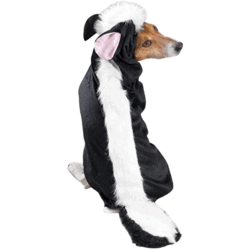
On the plus side, you now know your dog’s Halloween costume. May we suggest this adorable skunk getup for full-circle closure.
Frequently Asked Questions
Got questions after your dog was sprayed by a skunk? You’re not alone.
Skunk encounters turn even the chillest dog parents into frantic Googlers. Here’s a breakdown of the most common questions dog owners ask after their pup gets up close and personal with a stink bomb.
Don’t see your question? Ask us in the comments!
Can I Use Baby Shampoo Instead Of The De-Skunk Mix?
Baby shampoo is gentle and tear-free, but it’s not powerful enough to tackle skunk spray.
The reason is chemical: skunk oil contains thiols, which are sulfur compounds that cling to fur like static to fleece. You need a solution that breaks down those thiols—something baby shampoo can’t do on its own.
That’s why the hydrogen peroxide, baking soda, and dish soap formula works so well. The mixture oxidizes the thiols, neutralizing their stench.
Use baby shampoo for follow-up baths, not the initial cleanup.
How Long Will The Smell Last If I Don’t Treat It?
If untreated, the skunk odor can linger on your dog’s coat for two to three weeks—or longer. It also transfers easily to your furniture, clothes, and even the air in your home.
The scent becomes fainter over time but can still be noticeable, especially when the dog gets wet.
Immediate treatment with a de-skunking solution makes a massive difference. Letting the smell “wear off” is a gamble that often backfires with guests, roommates, and your own sense of smell.
Are There Professional Products That Work Better?
Yes, there are. Many pet stores and veterinarians sell enzyme-based de-skunk shampoos formulated specifically to dissolve skunk oil. These are often more effective for deeply soaked fur or cases where DIY efforts didn’t fully do the job.
Look closely for products labeled “oxidizing” or “enzyme-based” and follow the directions. Some even come with sprays for furniture or fabric, which can save your couch from eternal stinkdom.
Is It Dangerous If My Dog Was Sprayed In The Face?
Absolutely, it can be. Skunks often aim for the eyes, nose, and mouth to disable a perceived threat. This can result in eye irritation, nausea, temporary blindness, and respiratory distress.
If your dog is drooling, pawing at its face, or acting lethargic, don’t wait—call your vet.
You can gently flush your dog’s eyes with sterile saline and clean the face with a cloth soaked in the de-skunk solution, avoiding direct contact with eyes or mouth. But medical attention is best if symptoms persist.
Can I Prevent Skunks From Coming Into My Yard Again?
You can’t guarantee it, but you can make your yard a whole lot less appealing.
Skunks are nocturnal scavengers, so remove anything they might snack on: dog food, compost, birdseed, trash. Seal off crawlspaces and porch areas where they might hide.
Add motion-activated lights or sprinklers to startle them away. And for the particularly bold skunks, sprinkle citrus peels or ammonia-soaked cotton balls near entry points; they hate strong smells almost as much as we hate theirs.
Medical Concerns
Be sure to check your dog over for any injuries as well. If there is a bite or scratch on your dog, you’ll want to visit the vet since skunks can carry rabies and other diseases. If your dog is foaming at the mouth, you’ll want to get him to the vet as fast as possible.
